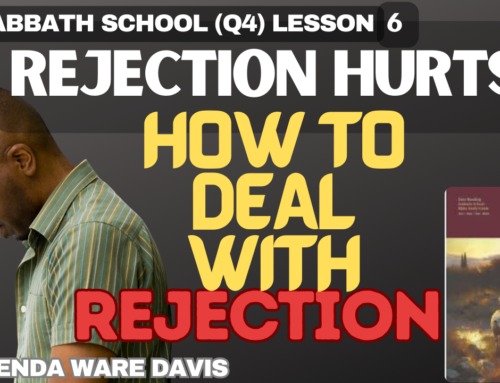God is not reactive; He is proactive. Reactive is responding after the fact. Proactive is having a plan or process in place before something happens. This is evident in God’s response to sin. When did God develop a plan to respond to the terrible emergency of sin, and when was it put into effect?
Sin, Evil, Death, Dying, and What Happens After We Die
This series addresses the concerns we all have: the concern for sin, evil, death, dying, and what happens after we die. Is there hope after death? When God created us humans, he intended for us to live forever in a loving, peaceful relationship with him. But this relationship has been broken by sin.
Here, we address the origin of sin and look more closely at death and dying.
But, instead of looking at death negatively, we look at it in the context of hope, the promised hope based on what Jesus did for us when he died and came back to life again.
From the Sabbath School Adult Bible Study Guide 2022 Quarter 4: Sabbath.School (See also Hope Sabbath School and 3ABN Sabbath School)
Visit SabbathSchoolDaily.com for more videos like this one.
Inviting God’s Presence
Thank You, Father, for the gentle lamb Jesus Christ, the Messiah who gave up his life as a sin offering for us. He is worthy of our worship and our praise. Amen
Many of our leaders today are reactive. They respond after the fact, even though they may see what is coming ahead, they refuse to devise a plan and only react after something bad happens. God is not reactive. He is proactive. His plan for Jesus to die was not put in place in response to Adam and Eve’s sin. His plan to save the world was not an afterthought.
How do we know this:
Revelation 13:8 speaks of
“The Book of Life of the Lamb who has been slain from the foundation of the world. (Revelation 13:8)
Acts 2:23 talks of
“Him, (Jesus) being delivered by the determined purpose and foreknowledge of God” (Acts 2:23)
and 1 Peter 1:19, 20 lets us know that we have been redeemed by
19 “the precious blood of Christ, as of a lamb without blemish and without spot.
20 He indeed was foreordained before the foundation of the world but was manifest in these last times for you. (1 Peter 1:19, 20)
John in Revelation 13:8 speaks of those on the earth worshipping the Beast, “whose names have not been written in the Book of Life of the Lamb slain from the foundation of the world” (Rev. 13:8, NKJV)”
The crucial point here is The Lamb slain that is killed before the foundation of the world. What is John saying here? What does he mean?
We must remember that Revelation is a book filled with symbols. This Lamb represents Christ.
But, we know, historically speaking, that Jesus didn’t die on the cross until thousands of years after the earth was created.
This verse lets us know that God planned to save us, humans before He created the earth. That’s proactive!
Central to that plan would be Jesus’ death on the cross. It would be Jesus, the Lamb of God, who would die on the cross.
So, how long ago did God develop the plan to save us, sinners? Titus 1:2 help us answer this question. It says:
2 in hope of eternal life which God, who cannot lie, promised before time began, (Titus 1:2)
It was put in place before time began!
In the classic book, The Desire of Ages, it says:
“The plan for our redemption was not an afterthought, a plan formulated after the fall of Adam. . . . It was an unfolding of the principles that from eternal ages have been the foundation of God’s throne.”—Ellen G. White, The Desire of Ages, p. 22.
His saving plan was first revealed to Adam and Eve in the Garden of Eden according to Genesis 3:15, 21. When he says to Satan:
15 And I will put enmity Between you and the woman, And between your seed and her Seed; He shall bruise your head, And you shall bruise His heel.”
And demonstrated to Adam and Eve when he killed an animal for the sake of clothing their naked bodies in Genesis 3:21
21 Also for Adam and his wife the Lord God made tunics of skin and clothed them.
This plan was also revealed to everyone after them by the slaying of every animal as a sacrifice. It was typified and symbolized by every blood sacrifice throughout the Old Testament era.
In other words, God’s saving plan was seen in every animal killed and offered to God as a sacrifice.
An example of God’s saving plan was displayed in the test of faith that God gave Abraham. In which he told Abraham to offer his only son as a sacrifice. After passing the test, God provided a male sheep to be killed as a substitute for Isaac, according to Genesis 22:11–13.
11 But the Angel of the Lord called to him from heaven and said, “Abraham, Abraham!” So he said, “Here I am.”
12 And He said, “Do not lay your hand on the lad, or do anything to him; for now I know that you fear God since you have not withheld your son, your only son, from Me.”
13 Then Abraham lifted his eyes and looked, and there behind him was a ram caught in a thicket by its horns. So Abraham went and took the ram, and offered it up for a burnt offering instead of his son. (Genesis 22:11-13)
What did this substitute represent?
It symbolized the future death of Jesus for our sins on the cross. This replacement typified the substitutionary nature of Christ’s atoning sacrifice on the cross.
Simply put, Jesus is our Substitute. He paid for our sins with His own life.
Hence, central to the whole plan of salvation is the substitute of Jesus’ death on the cross for our death.
The centuries of animal sacrifices, in which every animal was offered to God, symbolized Jesus’ death as the “the Lamb of God, which taketh away the sin of the world” (John 1:29).
Paul showed how closely God had linked the sacrificial service with the prophecies relating to the One who was to be “brought as a lamb to the slaughter.” The Messiah was to give His life as “an offering for sin.” Looking down through the centuries to the scenes of the Saviour’s atonement, the prophet Isaiah had testified that the Lamb of God “poured out His soul unto death: and He was numbered with the transgressors, and He bares the sin of many, and made intercession for the transgressors.” Isaiah 53:7, 10, 12.
The Saviour of prophecy was to come, not as an earthly king, to deliver the Jewish nation from earthly oppressors, but as a man among men, to live a life of poverty and humility, and at last to be despised, rejected, and slain. The Saviour foretold in the Old Testament Scriptures was to offer Himself as a sacrifice on behalf of the fallen race, thus fulfilling every requirement of the broken law. In Him, the sacrificial types (symbols) were to meet their antitype (He whom the characters represented), and His death on the cross was to lend significance to the entire Jewish economy.—The Acts of the Apostles, p. 227. Adapted
Yes, it is true that animal offerings are gruesome, bloody, and ugly. But this gruesome, bloody, and ugly death teaches a critical point.
Sin comes at a terrible price. The price for sin is death. As sinners, we deserve death. However, because Jesus loves us so much, He paid the ultimate price for our sins! He substituted His perfect life for our imperfect life.
Many do not understand just what Jesus has done for them and what it means that he will return to this earth a second time to get those who have accepted his death as a substitute in the place of their second death.
Of course, we all will die, but those who do not accept Jesus will experience a second death in which there will be no resurrection. They will be annihilated, wiped out of existence.
Even his disciples did not fully understand Jesus’ purpose in coming to this earth. What was their reaction when Jesus predicted his own suffering and death? Find out in Day 2: A Preface to the Cross
Watch Our Past and Present Lessons @ SabbathSchoolDaily.com.



